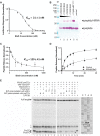Blasticidin S inhibits mammalian translation and enhances production of protein encoded by nonsense mRNA
- PMID: 34157102
- PMCID: PMC8287960
- DOI: 10.1093/nar/gkab532
Blasticidin S inhibits mammalian translation and enhances production of protein encoded by nonsense mRNA
Abstract
Deciphering translation is of paramount importance for the understanding of many diseases, and antibiotics played a pivotal role in this endeavour. Blasticidin S (BlaS) targets translation by binding to the peptidyl transferase center of the large ribosomal subunit. Using biochemical, structural and cellular approaches, we show here that BlaS inhibits both translation elongation and termination in Mammalia. Bound to mammalian terminating ribosomes, BlaS distorts the 3'CCA tail of the P-site tRNA to a larger extent than previously reported for bacterial ribosomes, thus delaying both, peptide bond formation and peptidyl-tRNA hydrolysis. While BlaS does not inhibit stop codon recognition by the eukaryotic release factor 1 (eRF1), it interferes with eRF1's accommodation into the peptidyl transferase center and subsequent peptide release. In human cells, BlaS inhibits nonsense-mediated mRNA decay and, at subinhibitory concentrations, modulates translation dynamics at premature termination codons leading to enhanced protein production.
© The Author(s) 2021. Published by Oxford University Press on behalf of Nucleic Acids Research.
Figures





Similar articles
-
Blasticidin S inhibits translation by trapping deformed tRNA on the ribosome.Proc Natl Acad Sci U S A. 2013 Jul 23;110(30):12283-8. doi: 10.1073/pnas.1304922110. Epub 2013 Jul 3. Proc Natl Acad Sci U S A. 2013. PMID: 23824292 Free PMC article.
-
Mechanistic insights into the alternative translation termination by ArfA and RF2.Nature. 2017 Jan 26;541(7638):550-553. doi: 10.1038/nature20822. Epub 2016 Dec 1. Nature. 2017. PMID: 27906160
-
tRNA mimicry in translation termination and beyond.Wiley Interdiscip Rev RNA. 2011 Sep-Oct;2(5):647-68. doi: 10.1002/wrna.81. Epub 2011 Mar 30. Wiley Interdiscip Rev RNA. 2011. PMID: 21823227 Review.
-
Structure of a human translation termination complex.Nucleic Acids Res. 2015 Oct 15;43(18):8615-26. doi: 10.1093/nar/gkv909. Epub 2015 Sep 17. Nucleic Acids Res. 2015. PMID: 26384426 Free PMC article.
-
Dbp5/DDX19 between Translational Readthrough and Nonsense Mediated Decay.Int J Mol Sci. 2020 Feb 6;21(3):1085. doi: 10.3390/ijms21031085. Int J Mol Sci. 2020. PMID: 32041247 Free PMC article. Review.
Cited by
-
Phenotypic Array for Identification and Screening of Antifungals against Aspergillus Isolates from Respiratory Infections in KwaZulu Natal, South Africa.J Fungi (Basel). 2023 May 26;9(6):616. doi: 10.3390/jof9060616. J Fungi (Basel). 2023. PMID: 37367552 Free PMC article.
-
Inhibition of the Eukaryotic 80S Ribosome as a Potential Anticancer Therapy: A Structural Perspective.Cancers (Basel). 2021 Aug 31;13(17):4392. doi: 10.3390/cancers13174392. Cancers (Basel). 2021. PMID: 34503202 Free PMC article. Review.
-
Semisynthetic blasticidin S ester derivatives show enhanced antibiotic activity.RSC Med Chem. 2023 Mar 8;14(4):782-789. doi: 10.1039/d2md00412g. eCollection 2023 Apr 26. RSC Med Chem. 2023. PMID: 37122539 Free PMC article.
-
Molecular basis of the pleiotropic effects by the antibiotic amikacin on the ribosome.Nat Commun. 2023 Aug 3;14(1):4666. doi: 10.1038/s41467-023-40416-5. Nat Commun. 2023. PMID: 37537169 Free PMC article.
-
No-nonsense: insights into the functional interplay of nonsense-mediated mRNA decay factors.Biochem J. 2022 May 13;479(9):973-993. doi: 10.1042/BCJ20210556. Biochem J. 2022. PMID: 35551602 Free PMC article. Review.
References
-
- Wilson D.N. Ribosome-targeting antibiotics and mechanisms of bacterial resistance. Nat. Rev. Microbiol. 2014; 12:35–48. - PubMed
-
- Yamaguchi H., Tanaka N.. Inhibition of protein synthesis by blasticidin S. II. Studies on the site of action in E. coli polypeptide synthesizing systems. J. Biochem. 1966; 60:632–642. - PubMed
-
- Yamaguchi H., Yamamoto C., Tanaka N.. Inhibition of protein synthesis by blasticidin S. I. Studies with cell-free systems from bacterial and mammalian cells. J. Biochem. 1965; 57:667–677. - PubMed
Publication types
MeSH terms
Substances
Grants and funding
LinkOut - more resources
Full Text Sources
Molecular Biology Databases

